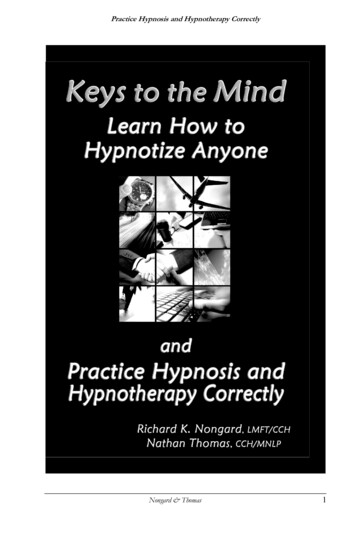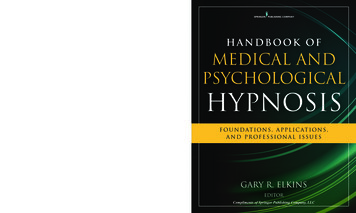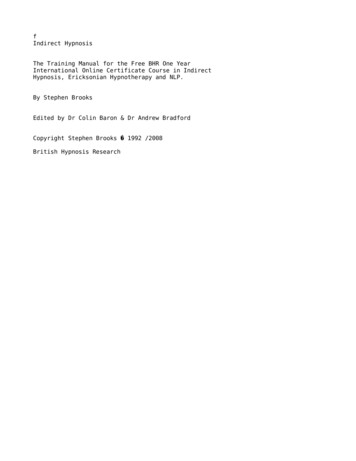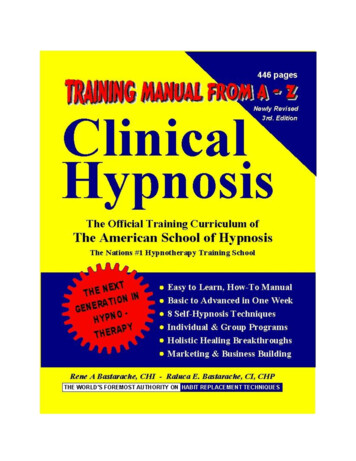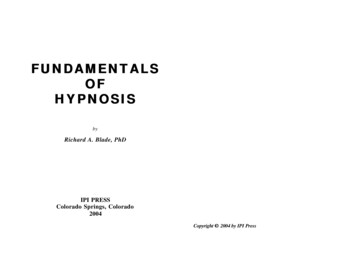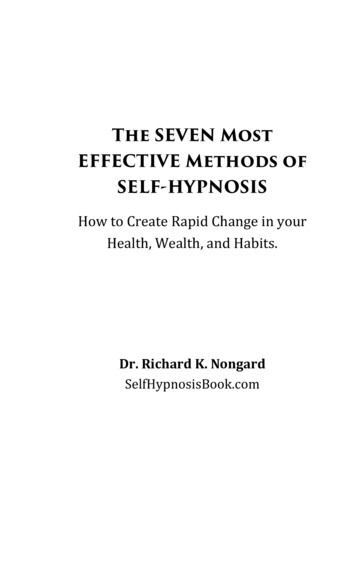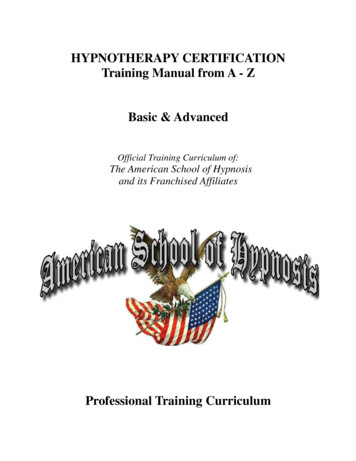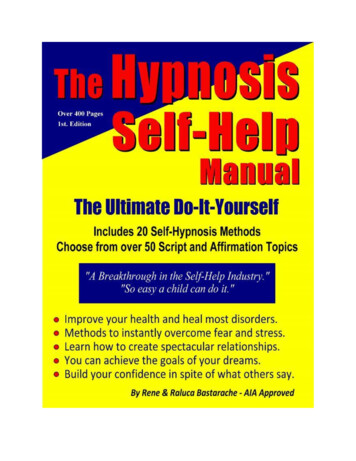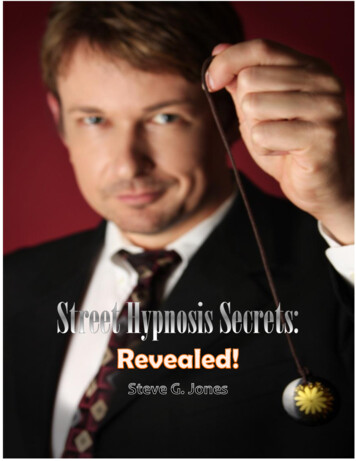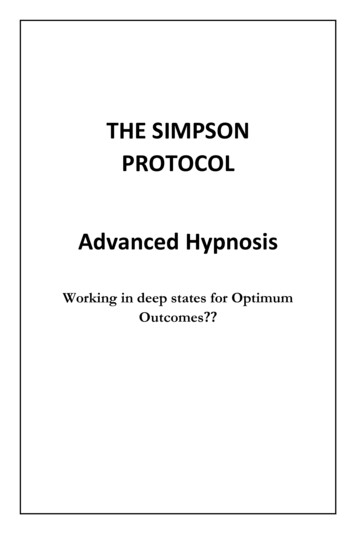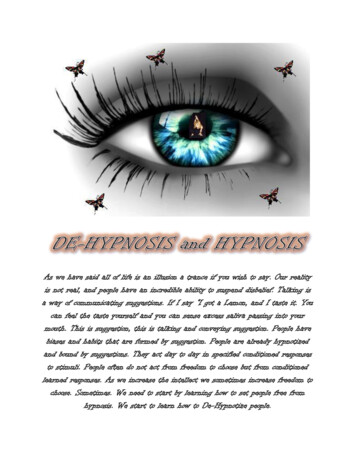
Transcription
As we have said all of life is an illusion a trance if you wish to say. Our realityis not real, and people have an incredible ability to suspend disbelief. Talking isa way of communicating suggestions. If I say “I got a Lemon, and I taste it. Youcan feel the taste yourself and you can sense excess saliva passing into yourmouth. This is suggestion, this is talking and conveying suggestion. People havebiases and habits that are formed by suggestion. People are already hypnotizedand bound by suggestions. They act day to day in specified conditioned responsesto stimuli. People often do not act from freedom to choose but from conditionedlearned responses. As we increase the intellect we sometimes increase freedom tochoose. Sometimes. We need to start by learning how to set people free fromhypnosis. We start to learn how to De-Hypnotize people.
Always remember 60% of the people are more prone to suggestion. They are more easilyinfluenced. They respond to placebos better and follow others. The other 40% are resistant.They are sometimes lacking in vision, very pragmatic and cautious. If you ask someone tosee his mother’s face in the color purple and they look up to the right they are probably agood subject. If the stare at you and widen their eyes they are a very good subject. If theylook to the sides or down, they are most probably a bad subject. Sometimes it is hard to tell.Hair Removal with Hypnosis Advert- It is possible
Believe it or not, hypnosis is a very natural state that we go in and out of every day,most of the time without knowing it. For instance, like when we're driving on the freewayand miss an exit; or when we become so engrossed in a movie we start to cry or laugh withthe characters, even though we know it's not real. Every night we go into a state of deephypnosis or hypnogogic sensitivity for about 30 minutes before we fall asleep. And everymorning when we first awaken we are in hypnosis. It is that dreamy feeling, in betweenbeing asleep and fully awake.When we are in hypnosis, we are in an altered state of consciousness, which is really just aheightened state of awareness. We feel physically relaxed, mentally alert and fully awareof our surroundings. Because this is a time when both our conscious and subconscious mindsare present, it is a state where we are more suggestible and the subconscious is open andreceptive to positive suggestions and sensory experiences.Consequently, we use the hypnotic state therapeutically to give powerful positive suggestionsthat the subconscious will accept and act upon, ultimately aligning with the conscious desiresto change and the freedom to stop acting blindly to conditioned stimuli.Much of witchcraft is just actually suggestion. Do not over use it or undervalue it, but learnit well. Hypnosis is thought to work by altering our state of consciousness in such a way thatthe analytical left-hand side of the brain is turned off, while the non-analytical right-handside is made more alert. The conscious control of the mind is inhibited, and the subconsciousmind awoken. Since the subconscious mind is a deeper-seated, more instinctive force thanthe conscious mind, this is the part which has to change for the client's behavior andphysical state to alter.For example, a client who consciously wants to overcome their fear may try everything theyconsciously can to do it, but will still fail as long as their subconscious mind retains thisterror and prevents the client from succeeding. Progress can only be made by long termreprogramming the subconscious so that deep-seated instincts and beliefs are abolished oraltered.Increasing suggestibility in a person you are talking to, such that they will provideinformation or follow instructions without resistance, is a relatively straight forward process.Such "fast inductions" can be executed one at a time, or in combinations, in order to achieveeffects ranging from increased rapport to therapeutic trance. The smooth talker and thepowerful sales person has the power of subtle hypnosis.
I was trained as a medical hypnotist in Ohio. I hypnotized many patients to go thru surgeryand for other reasons in the Hospital. And I was a stage hypnotist at YSU and I had a TVshow as a psychic and hypnotized people on TV many times. I was quite well renown as amedical hypnotist.Pattern Interrupt: Perhaps the easiest way to execute a fast induction is simply to interrupta process that people always complete without interruption. If you ask someone to sign theirname, then interrupt the process, they will wait in a very suggestible state to complete thatprocess. If you reach out to shake their hand then hand them something to hold, or askthem to provide their address and disrupt the recitation, you will find they are verysuggestible for several seconds. Experiment with interrupting a pattern, and then issuing aninstruction someone might otherwise be somewhat disinclined to obey. You'll be astoundedthat the instruction is almost always obeyed without thinking. The important thing is tomake sure that the operation is fully underway when it is interrupted, and that the
instruction is very easy to follow. You can "deepen" the trance by executing another patterninterrupt and then giving an instruction.Start a Good Story or Great Joke: Let's be clear. People listening to a good story or joke arein a subtle trance state. They are actively listening to you. They have tuned out distractions.They are waiting for your next word. They wait in wonder for the punch line. Instructionsissued when people are in that state are most often followed. There is a good reason why thefirst few minutes of a film usually startle or surprise people, and it is not at all surprisingthat some films seem to have life changing impacts on people. Milton Erickson, the father ofNLP, developed signature methods to trance and transform patients other therapists hadgiven up on. To use this form of fast induction, start the story or joke, then give asuggestion or instruction. To deepen the trance, try starting a second story within the first.Use Touch: An unexpected touch is a very powerful induction. Coaches and teachers haveoften used a hand on the shoulder to make a player or student more attentive. Salesmenoften execute a "close" after they've clapped someone on the arm. Touch can be a verydangerous induction technique, in this day and age, but it is undoubtedly one of the mostpowerful. Even total strangers will often respond to an instruction given after you havetouched them on the arm or back.Used in a right and therapeutic way, these techniques can help people step over a lot ofroad blocks. A doctor seeking to put a patient at ease may find that he can reduce pain in a
patient more quickly using a fast induction and a direct suggestion that the patient feel"better now".Less honest folks use fast inductions to hurt people. Pick pockets often bump a victim hardenough to make them stumble, then steal a wallet or watch as they "help" them recover. Conmen will often use a confusing story prior to asking someone hand over something of value.Serial rapists and serial killers will typically use a "trick" to widen a window of opportunity.They may follow you to your car at the supermarket and pick up one of your bags (a patterninterrupt) or start a confusing story as they walk toward you.It is important to understand that almost everyone is more suggestible when confused ordistracted. Very confused and distracted people are extremely suggestible. A time of personalcrisis is not the best time to make big decisions based on advice from strangers.You will be very surprised, and perhaps a bit frightened, by just how well these fastinduction techniques work with a bit of practice.An easy induction that I do on stage is to say to the audience, “Watch as I take a lemon outof pocket” I then show that there is no real lemon but I pretend. Then I say” Watch as Itaste the lemon “I pretend to cut the lemon in half and then I put it to my mouth andmake a face like I was tasting a sour lemon. I watch as most of the audience will make thesame face. I can see the release of salvia in them. These are good clients for hypnosis. I tellthe audience they were hypnotized into a body physical reaction and there was no lemon, justsuggestion.Now then on stage I tell them “please stretch out your hands with your right thumb pointingupwards in front of you. Now look at your thumb with one eye. See the thumb, hold the
image and close your eyes. Now lower your hand but still see the thumb in the air. Look atthe thumb, see the thumb in your mind.” The ones who hold their head steady for fiveseconds or more and do not look down or open their eyes are very good clients for hypnosis. Itell them all to relax and I now appear to choose people at random from the audience butinstead I choose the good clients for the show. Stage hypnosis is great and you really can geta person to act as a chicken. They seem to have better abilities to respond to suggestion onstage.Now normal day to day meetings are also easy but you have to be careful to respect aperson’s privacy and dignity. You might go the whole route of your tired and your eyes areheavy. This is for a full induction of deep trance, like we all have seen on TV a hundredtimes. But as a hypnotist if you want to be more clever you need only use normal talking toplant your suggestion. If I say “Don’t think of elephants” you must think of elephants. Thebrain treats don’t in a special two brain way. It often ignores it. If you say to your childclimbing a fence “Don’t fall” the child’s brain must access the word fall and visualize it andthus has an increased ability to fall. Don’t goes to one part and the next suggestion goeselsewhere. So if I say “Don’t you think I am Beautiful”’ the person will get the suggestionand agree with me. Then I am also planting the suggestion. If I see that this is workingthen the removal of the don’t can work with “Please release your inhibitions and relax intolife’s little pleasures, the intensity of anticipation is one of the pleasures.” Use this gradualway to get suggestions for health, wellness and to dehypnotize or give suggestions for your
clients or for your incantations. In my book on stopping smoking I go into more detail onaddiction release with hypnosis.If you say don’t smoke there is a subtle suggestion to smoke. So to avoid the negativity andinfluence of the don’t you should say “Keep your Lungs Clean”, “Make your blood Healthy”,or “Control your Mind”, “Control Your Will”. These are examples of positive suggestions.I use negative suggestions with smoking to say “When you taste a cigarette, it will taste likedog shit”, or “When you smoke you will feel the sickness of the tobacco eating away at yourbody”.
Hypnotic HandshakesThe Hypnotic Handshake method is based on ‘brief hypnosis’. Brief hypnosis is a less knownform of hypnotizing; I learned this from Dr. Milton H. Erickson in 1977. Erickson alsotaught the Hypnotic Handshake method based on the philosophy of brief hypnosis.When I attended a seminar by Erickson, he taught us the handshake induction. Just beforelunch he took three people and did the handshake induction on them. He suggested to themunder hypnosis that they would have the most incredible lunch ever. They would have theirmost perfect dream lunch. We all went to a mediocre lunch and when we returned theywere still sitting there. When he awoke them from their trance they reported having the
most incredible lunch. We all drooled at the stories they told of wonderful culinary delights.I have used this many times on stage and in practice.Most people enter trance (the hypnotic state of mind) and exit trance many times duringthe day. Some people say that all of life is a trance.One good example would be driving on the freeway while you’re figuring out what to say toyour boss about you being late again (for the 29th time this month). Not being awarecompletely to the road and to the driving activity, you still make it in one piece to the office.That’s hypnosis.Brief hypnosis starts with a rapid induction to get a person into trance. Rapid induction isbased on two key principles:Rapid Induction Principle No. 1:Interrupt the auto-pilotWe are predictable creatures. Lift your right hand toward someone, say Hi, smile, and hewill automatically lift his right hand to shake yours. He didn’t even think about it, ithappened automatically. It’s the auto-pilot. One of many automatic behaviors we’re known ofdoing without conscious judgment.
If you interrupt an automatic behavior like this, you create an empty space, a query in theother person’s mind, a brief window to the subconscious mind. It takes less than a second forthat window to close, so you’d better act fast.Rapid Induction Principle No.2: Fill the blankNow that the automatic pattern is missing, fill the blank quickly. The other person willfollow if it’s done immediately after the interruption, because our minds don’t like voids.They want completion.Do something that will restore the missing link. Use hypnotic language and fast pacinginduction script while talking in your regular voice.Now that you know the key principles of rapid induction in brief hypnosis, let’s move on toshow you the Hypnotic Handshake method:Step 1: Interrupt the Auto HandshakeLet’s say you’re going to hypnotize Joe. Joe is a nice guy, but he deserves to be hypnotizedand positively abused (meaning he will be happy during and after the session).You meet Joe, smile at him, look him directly in the eyes and you lift your right handtoward him for a handshake. Now stay alert!For the handshake interrupt, as Joe’s hand comes up, you form a cup with your thumb andfirst finger. Instead of meeting Joe’s right hand with yours, you put your hand in cup formunder his hand that is coming to shake.But then your hand goes back just a little bit—don’t pull it way back, just an inch. Theother hand goes behind the wrist
hypnosis or hypnogogic sensitivity for about 30 minutes before we fall asleep. And every morning when we first awaken we are in hypnosis. It is that dreamy feeling
